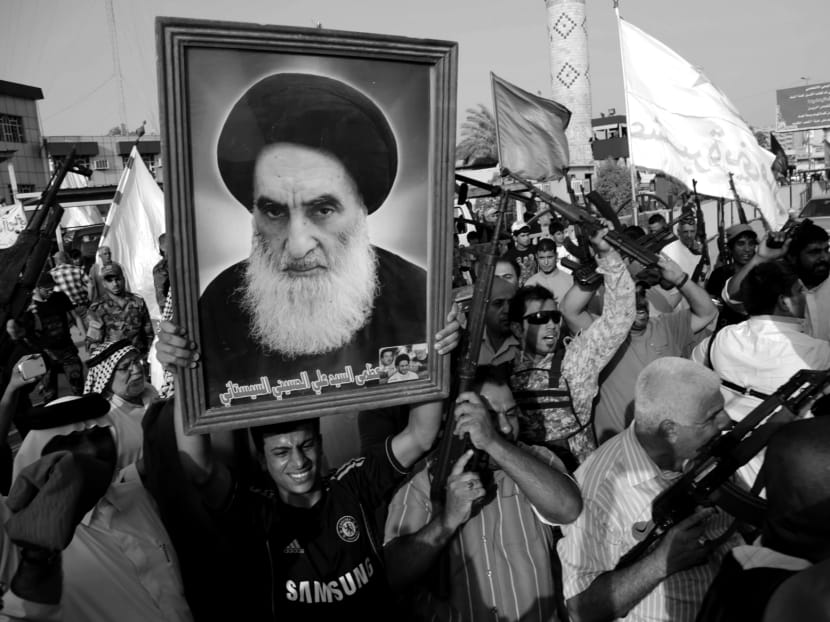Religion masks lust for power in Middle East
The conflict convulsing Syria and Iraq, and bursting regional borders, is being likened to a religious war, similar to the 30 Years War, which devastated Europe in the first half of the 17th century. However, this does not quite ring true.

Iraqi Shia fighters in a demonstration against ISIS. The poster depicts Shia spiritual leader Grand Ayatollah Ali Al Sistani, who has issued a fatwa in defence of Iraq that de facto is a call to arms for the Shia against the Sunni jihadi menace of ISIS. PHOTO: AP
The conflict convulsing Syria and Iraq, and bursting regional borders, is being likened to a religious war, similar to the 30 Years War, which devastated Europe in the first half of the 17th century. However, this does not quite ring true.
The warriors of the new caliphate — the Islamic State of Iraq and Syria (ISIS) which, intoxicated with sudden success, has self-distilled into the Islamic State — are, in theological terms, painting by numbers. Such legitimacy as they have in their jihadistan is ephemeral, leeched from collapsing unitary states with oppressive rulers, who have driven the Sunni masses temporarily into their bloodstained arms.
This is not so much a war of religion as a struggle for power bespattering the region, in which rival Islamic identities — Sunni and Shia — have replaced nationalism as the mobilising agent, and the states with most interest in the outcome, Saudi Arabia and Iran, have (to paraphrase Shakespeare) cried havoc and let slip the dogs of sectarianism.
Theology enters into it peripherally, insofar as an acknowledged authority, such as Grand Ayatollah Ali Al Sistani — the marja’a or “source of emulation” for millions of Shia in Iraq and around the world — who has issued a fatwa in defence of the Iraqi nation that de facto is a call to arms for the Shia against the Sunni jihadi menace of ISIS. Sectarianism escapes the control of those who touch it, much less unleash it.
THE RISE OF SECTARIANISM
Saddam Hussein, the late Iraqi tyrant, used nationalism to fight Iran during the 1980s, but sought to emulate his hero, Stalin, with a religious values campaign in the 1990s. That was meant to stiffen popular resolve against international sanctions, but it opened doors for Sunni and Shia irredentism, and what Dr Charles Tripp, the Iraq scholar, calls sectarian entrepreneurs.
But there is plenty of blame to go round. The United States-led invasion of Iraq in 2003, which overturned the regional balance of power in favour of the Shia (a minority in Islam, but a majority in Iraq, as in Persian Iran), rekindled the millenarian embers of the seventh-century schism within Islam between Sunni and Shia.
The irredeemable sectarianism of Mr Nouri Al Maliki — the Prime Minister who hoards power and patronage for the Da’wa, his own Shia Islamist faction, and who began as a US protege to end as an Iranian client persecuting and purging Sunni leaders and activists — fanned the flames.
Western policy in Syria has poured more petrol on the fire by failing to support mainly Sunni mainstream rebels against President Bashar Al Assad’s regime, built around Syria’s Alawite minority, an offshoot of Shiism. That created a vacuum for the jihadis, facilitated by Western-allied Sunni powers: Wahhabi Saudi Arabia and Qatar as well as Turkey. A Wahhabi is a member of a strict orthodox Sunni Muslim sect. ISIS is riding a wave of Sunni rebellion from Syria into western and northern Iraq. But religion here is secondary to identity and sense of entitlement.
When governments and oppositions — and states, such as Iran and Saudi Arabia, which back them — play the sectarian card, this prevents popular grievances becoming a dispute between haves and have-nots, or about access to power and opportunity. Would-be citizens who might seek common institutions to arbitrate their interests are instead faced with the hard-wiring of sectarian affiliation and subconscious grammar of tribal loyalty, which spills across the Syrian and Iraqi borders into Saudi Arabia and Jordan.
In Iraq, for example, Mr Qassem Soleimani, master puppeteer of Iran’s Revolutionary Guard, is stitching together a Shia militia network like the one he built in Syria for the Assads. Mr Maliki urgently needs this irregular force after Iraq’s army, whose commanders he replaced with incompetent trusties, melted before the ISIS onslaught. Despite taking personal control of defence, Mr Maliki relies for his own protection on Iranian-trained militia. But the sectarian mould in Iraq has hardened such that almost everyone is looped into a circle of patronage and power.
PROTECTING IDENTITIES
ISIS fastened onto the Sunni power networks of Saddam’s army and Ba’ath Party, supposedly dismantled by the US-led occupation, and the tribes, hostile to jihadi totalitarianism, but now more aggrieved by the Maliki government. While sectarianism is not religion, it does have the power to resurrect the zombie ideologies of Osama bin Laden and the Ba’ath — and even get them to work together.
The Shia, after centuries on Islam’s sidelines, finally have something to protect. It is not only about preventing a repeat of 1801, when Wahhabi marauders from the first Saudi kingdom sacked Karbala and other Shia shrine cities. It is about 2003 and the rise of the Shia after the invasion of Iraq, which helped Tehran forge an axis of power from Baghdad to Beirut.
If this is a “30 years war”, it resembles more the convulsion of Europe between 1914 and 1944: Not competing nationalisms, but still a clash of aggrieved — in this case, sectarian — identities. The inhabitants exist in a common space that they cannot agree to share, amid yearning after past glory — a reich then, a caliphate now.
The Financial Times
ABOUT THE AUTHOR:
David Gardner is associate editor of The Financial Times.






